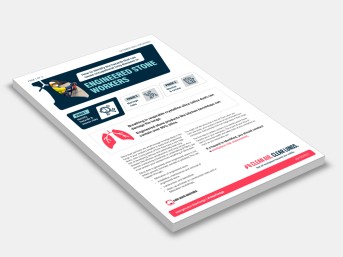How to identify the hazards that can cause occupational lung diseases in engineered stone workers: information sheet
Safe Work Australia
Silica dust particles are small enough to lodge deep in the lungs. If your workers breathe in dusts from engineered stone, over a long period of time, they have a very high risk of developing serious and potentially fatal lung diseases like silicosis, emphysema, and lung cancer. As a person conducting a business or undertaking (PCBU), you must protect your workers from breathing in silica dust.
Silica dust is generated when engineered stone is cut, drilled, ground, trimmed, sanded or polished. This can happen through:
• fabrication of engineered stone
• installation, maintenance and removal of engineered stone
• construction and demolition
• clean-up activities on construction sites and in fabrication workshops.
You might not see silica dust in the air. Even when you can’t see dusts, your workers may be at risk of breathing in microscopic dust particles that can lodge deep in their lungs.
The first step to protect workers is to identify where these hazards are in your workplace. This is part of your duty of care to minimise health and safety risks at your workplace as much as you reasonably can.
If a hazard is identified, you should conduct a workplace risk assessment.
